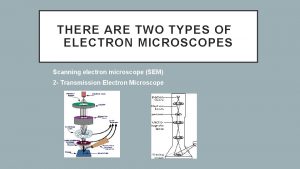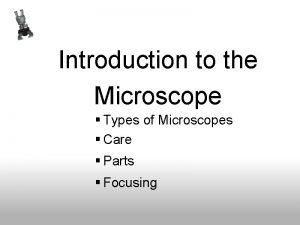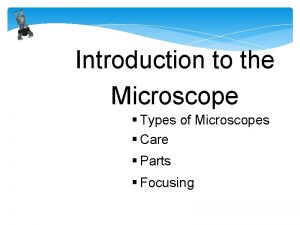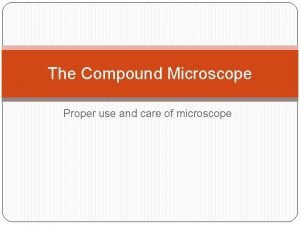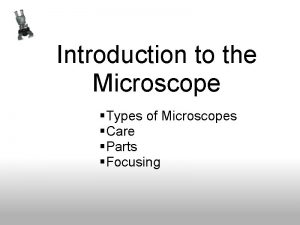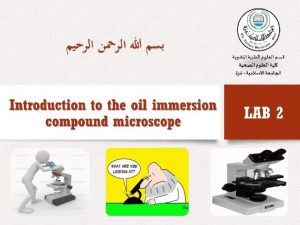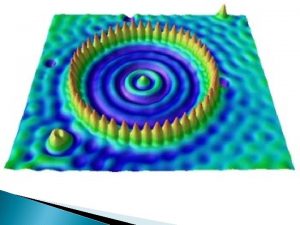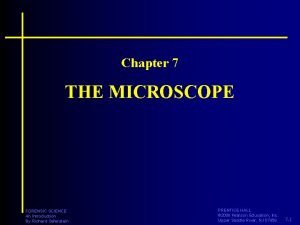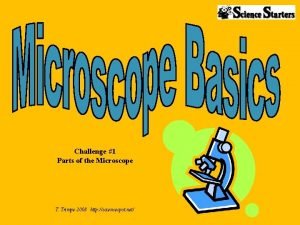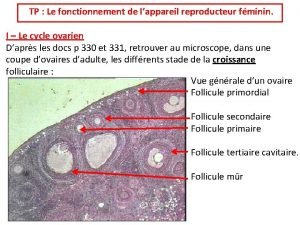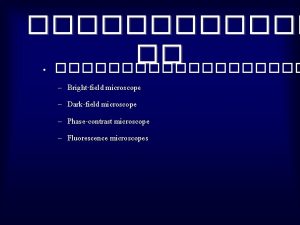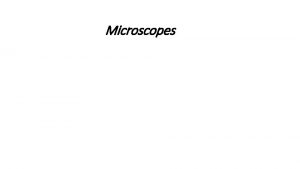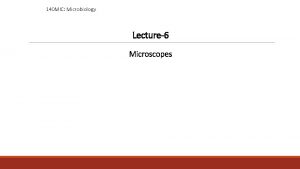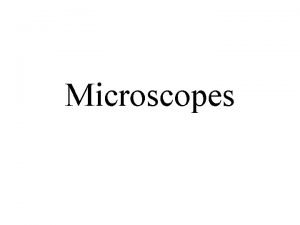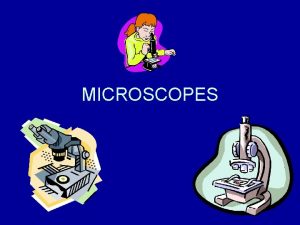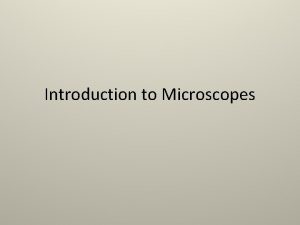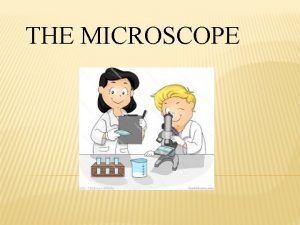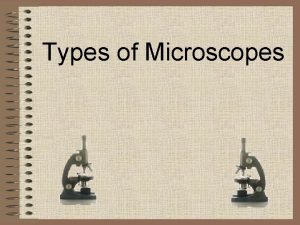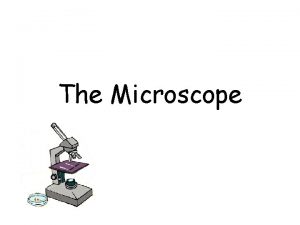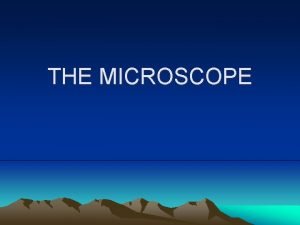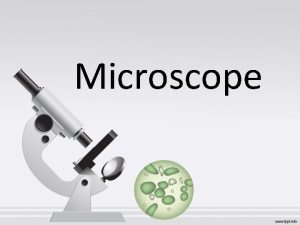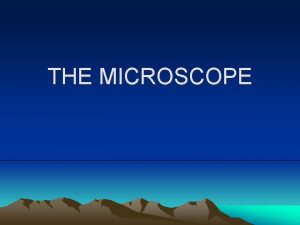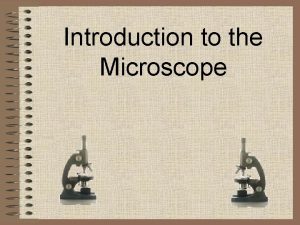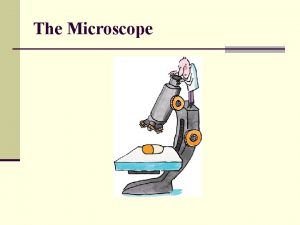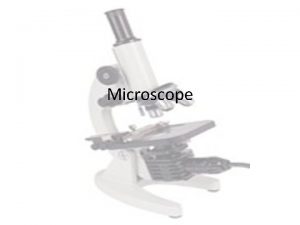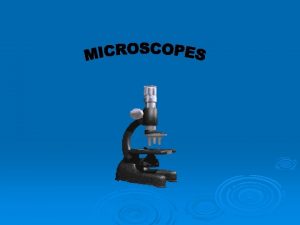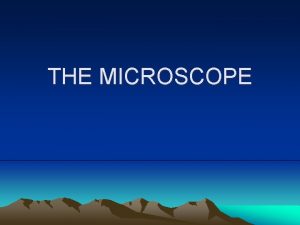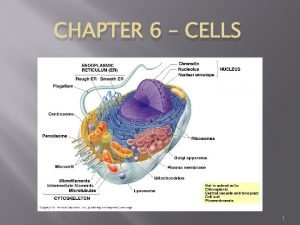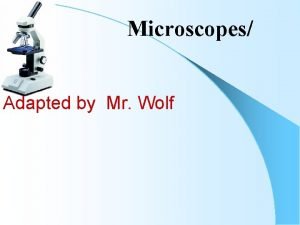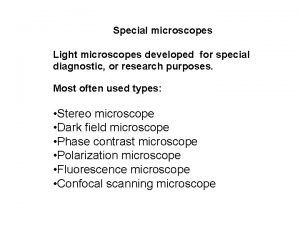The Microscopes The Microscope 1 The microscope is






















































- Slides: 54

The Microscopes

• The Microscope • 1. The microscope is an optical instrument that uses a lens or combination of lenses to magnify and resolve the fine details of an object.

• Magnifying glasses were the first microscopes. They made things look bigger because of the way light rays are bent by the glass.

• A compound microscope is used to get better magnification. They are made by using two lenses mounted at the end of a tube.

• The object is placed under the lower lens (the objective lens) and the magnified image is viewed through the upper lens (the eyepiece lens).

• The image formed by the objective lens is inverted and magnified. • The eyepiece lens magnifies it more.

• There are five types of microscopes used in forensics.

The Compound Microscope • 1. Consists of a mechanical system and an optical system.

• 2. The mechanical system is composed of a base, arm, stage, body tube, coarse adjustment, and fine adjustment.

• 3. The optical system consists of –a. An illuminator, which is a light source. For transparent objects the light source is placed underneath. This is called transmitted illumination.

When objects are not transparent the light must be placed above the object. This is vertical or reflected illumination.

• b. A condenser. The condenser collects light rays from the base illuminator and concentrates them on the object.

• c. An objective lens. Closest to the object. Most have two or three objectives (marked with the magnification). If the object stays in focus when switching objectives it is said to be parafocal.

• d. Eyepiece or ocular lens. Closest to the eye. One eyepiece = monocular, Two eyepieces = binocular.

• e. The ability of an objective lens to resolve details into 2 clear images instead of one blurry one is directly proportional to the numerical aperture value of the objective lens. The larger the N. A. , the better the detail.

• 4. To decide the power magnification you need to use always start out with the lowest power. Low magnification will give you a larger field of view. This means you will be able to see more of the object.

• The higher the magnification the smaller the field of view. • 5. Depth of focus is another function of magnifying power.

• This is the depth of the object that is in focus. The higher the magnification the shallower the depth of view.

The Comparison Microscope • 1. Gives forensic scientists the ability to do a side-by-side comparison of specimens.

• 2. It is basically two compound microscopes joined together by an optical bridge. • 3. Often used in ballistics to compare bullet marks.

The Stereoscopic Microscope • 1. The most commonly used and most versatile microscope used in forensic lab.

• 2. Not as powerful as other microscopes but it has a much larger working distance. This is the space between the specimen and the objective lens.

The Polarizing Microscope • 1. Most light vibrates in all directions perpendicular to the direction of the beam. Light can be passed through a polarizer which only allows light in one plane to pass through.

• The light that passes through is called planepolarized light. • Ex. Glare reducing sunglasses.

• If two polarizers are used the first is called a polarizer and the second is called an analyzer. • If they are held parallel to each other light will pass through them.

• If they are held perpendicular to each other no light passes through them. • 2. These microscopes are used to identify minerals and synthetic fibers.

The Microspectrophotometer • An instrument that links a microscope and a spectrophotometer. • It helps with identification and comparison of materials.

The Scanning Electron Microscope (SEM) • 1. The image is formed by aiming a beam of electrons onto a specimen and studying electron emissions on a closed circuit tv.

• 2. A beam of electrons is emitted from a tungsten filament and focused onto the specimen using electromagnets. • This is called the primary electron beam.

• When this beam hits the specimen it causes the elements on the surface to give off secondary electrons. • 20 - 30% of the electrons that hit the specimen bounce off.

• These are called backscatter electrons. • The secondary and backscatter electrons are collected and the amplified signal is displayed on a screen.

• The advantages of an SEM is the high level of magnification (up to 100, 000 times), the depth of focus is 300 times better than optical microscopes, and a superior resolution.












88888888888










 Types of electron microscopes
Types of electron microscopes Types of microscope
Types of microscope Which organelle breaks down organelles
Which organelle breaks down organelles Types of microscopes
Types of microscopes T.trimpe 2003 http //sciencespot.net/ answers
T.trimpe 2003 http //sciencespot.net/ answers Care and structure of the compound microscope
Care and structure of the compound microscope Types of microscopes
Types of microscopes Purpose of a microscope
Purpose of a microscope Electron microscopes main idea
Electron microscopes main idea Forensic science microscopes
Forensic science microscopes Microscope mania compound light microscope
Microscope mania compound light microscope Difference between light microscope and electron microscope
Difference between light microscope and electron microscope Bổ thể
Bổ thể Tư thế worm breton là gì
Tư thế worm breton là gì ưu thế lai là gì
ưu thế lai là gì Thẻ vin
Thẻ vin Thể thơ truyền thống
Thể thơ truyền thống Cái miệng xinh xinh thế chỉ nói điều hay thôi
Cái miệng xinh xinh thế chỉ nói điều hay thôi Các châu lục và đại dương trên thế giới
Các châu lục và đại dương trên thế giới Từ ngữ thể hiện lòng nhân hậu
Từ ngữ thể hiện lòng nhân hậu Diễn thế sinh thái là
Diễn thế sinh thái là Tư thế ngồi viết
Tư thế ngồi viết V cc cc
V cc cc Phép trừ bù
Phép trừ bù Chúa sống lại
Chúa sống lại Hổ đẻ mỗi lứa mấy con
Hổ đẻ mỗi lứa mấy con đại từ thay thế
đại từ thay thế Quá trình desamine hóa có thể tạo ra
Quá trình desamine hóa có thể tạo ra Vẽ hình chiếu vuông góc của vật thể sau
Vẽ hình chiếu vuông góc của vật thể sau Cong thức tính động năng
Cong thức tính động năng Hát kết hợp bộ gõ cơ thể
Hát kết hợp bộ gõ cơ thể Tỉ lệ cơ thể trẻ em
Tỉ lệ cơ thể trẻ em Thế nào là mạng điện lắp đặt kiểu nổi
Thế nào là mạng điện lắp đặt kiểu nổi Các loại đột biến cấu trúc nhiễm sắc thể
Các loại đột biến cấu trúc nhiễm sắc thể Lời thề hippocrates
Lời thề hippocrates Vẽ hình chiếu đứng bằng cạnh của vật thể
Vẽ hình chiếu đứng bằng cạnh của vật thể độ dài liên kết
độ dài liên kết Môn thể thao bắt đầu bằng chữ đua
Môn thể thao bắt đầu bằng chữ đua Sự nuôi và dạy con của hươu
Sự nuôi và dạy con của hươu điện thế nghỉ
điện thế nghỉ Thế nào là sự mỏi cơ
Thế nào là sự mỏi cơ Trời xanh đây là của chúng ta thể thơ
Trời xanh đây là của chúng ta thể thơ Frameset trong html5
Frameset trong html5 Voi kéo gỗ như thế nào
Voi kéo gỗ như thế nào Số nguyên tố là số gì
Số nguyên tố là số gì Thiếu nhi thế giới liên hoan
Thiếu nhi thế giới liên hoan Fecboak
Fecboak Các châu lục và đại dương trên thế giới
Các châu lục và đại dương trên thế giới Một số thể thơ truyền thống
Một số thể thơ truyền thống Thế nào là hệ số cao nhất
Thế nào là hệ số cao nhất Sơ đồ cơ thể người
Sơ đồ cơ thể người Tư thế ngồi viết
Tư thế ngồi viết đặc điểm cơ thể của người tối cổ
đặc điểm cơ thể của người tối cổ Mật thư anh em như thể tay chân
Mật thư anh em như thể tay chân Follicule secondaire observé au microscope optique
Follicule secondaire observé au microscope optique
